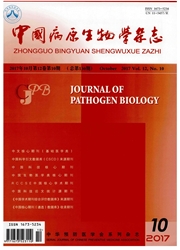

 中文摘要:
中文摘要:
目的建立裂头蚴感染小鼠模型。方法分别采用曼氏迭宫绦虫裂头蚴头部灌胃法和全虫喂饲法建立裂头蚴病小鼠模型,比较两种方法的感染率与裂头蚴生长情况;采用连续转种的方式观察灌胃法建立动物模型的稳定性。结果采用灌胃法和全虫喂饲法建立裂头蚴病小鼠模型,感染率分别为93.00%和91.00%,差异无统计学意义(χ2=0.272,P〉0.05);感染后2个月,两组剖检回收的裂头蚴长度分别为(5.13±1.71)cm和(5.56±1.26)cm,差异无统计学意义(t=-0.751,P〉0.05);感染2个月灌胃组裂头蚴长度平均增加(5.09±0.58)cm,喂饲法增加(2.37±0.937)cm,差异有统计学意义(t=27.034,P〈0.01)。每隔2个月对同一批裂头蚴应用灌胃法转种1次,连续转种18次后裂头蚴的感染性和活力无明显改变,每次转种时均可获取除头部外的新鲜虫体。结论用裂头蚴头部进行灌胃可建立稳定的裂头蚴感染小鼠模型。
 英文摘要:
英文摘要:
Objective To establish a mouse model of sparganosis. Methods Mice were intragastrically injected with plerocercoid larvae (with the scolex and neck) of Spirometra mansoni and mice were fed entire larvae to compare rates of infection and sparganum growth. The consistency of the mouse model of sparganosis was evaluated by continuously injecting mice intragastrically with the sparganum. Results Mice that were injected intragastrically had an infection rate of 93% (93/100) and mice that were fed entire larvae had an infection rate of 91% (91/100) (X2 =0. 272, P=0. 602). There were no statistical differences in the length of the sparganum recovered from two groups of infected mice 2 months after injection (5.09 cm vs. 2.37 cm, t=-0. 751, P=0. 454). In comparison to the initial length of the sparganum, the average increase in the length of the sparganum was 5.09 cm for mice that were injected intragastrically and 2.37 cm for mice that were fed entire larvae. The average sparganum growth was significantly greater in mice that were injected intragastrically in comparison to mice that were fed entire larvae (t= 27. 034, P=0. 000). There were no obvious changes in the rate of infection (90 %- 94%) and the viability of the s parganum after 18 injections at two-month intervals. Viable worms without a scolex were collected during each intragastric injection. Conclusion A consistent mouse model of sparganosis was successfully established by injecting the sparganum intragastrically.
 同期刊论文项目
同期刊论文项目
 同项目期刊论文
同项目期刊论文
 Analysis of structures, functions and epitopes of cysteine protease from Spirometra erinaceieuropaei
Analysis of structures, functions and epitopes of cysteine protease from Spirometra erinaceieuropaei Characterisation of the relationship between Spirometra erinaceieuropaei and Diphyllobothrium specie
Characterisation of the relationship between Spirometra erinaceieuropaei and Diphyllobothrium specie Identification of early diagnostic antigens from spirometra erinaceieuropaei sparganum soluble prote
Identification of early diagnostic antigens from spirometra erinaceieuropaei sparganum soluble prote Cutaneous gnathostomiasis with recurrent migratory nodule and persistent eosinophilia: a case report
Cutaneous gnathostomiasis with recurrent migratory nodule and persistent eosinophilia: a case report Analysis of structures, functions, and epitopes of cysteine protease from Spirometra erinaceieuropae
Analysis of structures, functions, and epitopes of cysteine protease from Spirometra erinaceieuropae Molecular characterization of a Spirometra mansoni antigenic polypeptide gene encoding a 28.7 kDa pr
Molecular characterization of a Spirometra mansoni antigenic polypeptide gene encoding a 28.7 kDa pr Characterization of Spirometra erinaceieuropaei Plerocercoid Cysteine Protease and Potential Applica
Characterization of Spirometra erinaceieuropaei Plerocercoid Cysteine Protease and Potential Applica Serodiagnosis of sparganosis by ELISA using recombinant cysteine protease of Spirometra erinaceieuro
Serodiagnosis of sparganosis by ELISA using recombinant cysteine protease of Spirometra erinaceieuro Levels of sparganum infections and phylogenetic analysis of the tapeworm Spirometra erinaceieuropaei
Levels of sparganum infections and phylogenetic analysis of the tapeworm Spirometra erinaceieuropaei Phylogenetic location of the Spirometra sparganum isolates from China, based on sequences of 28S rDN
Phylogenetic location of the Spirometra sparganum isolates from China, based on sequences of 28S rDN 期刊信息
期刊信息
